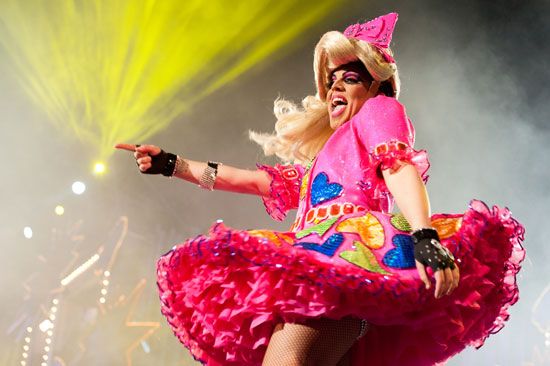drag queen
Our editors will review what you’ve submitted and determine whether to revise the article.
- BBC - Bitesize - The fabulous history of drag
- Academia - A Natural History of the Drag Queen Phenomenon
- Human Rights Campaign - Understanding Drag: As American as Apple Pie
- National Geographic - The early history of modern drag, from police raids to pop culture
- The Guardian - Why drag queens are racing to the rescue
- CNN - The US has a rich drag history. Here’s why the art form will likely outlast attempts to restrict it
- Key People:
- Marsha P. Johnson
- Sylvia Rivera
- Harvey Fierstein
- RuPaul
- Harvey Milk
- Related Topics:
- theatrical production
- transvestism
News •
drag queen, a man who dresses in women’s clothes and performs before an audience. Drag shows (typically staged in nightclubs and Gay Pride festivals) are largely a subcultural phenomenon. Though drag has never enjoyed mainstream appeal, drag queen is a common enough term in popular culture, partly because of recording artist RuPaul, who hit the charts with her hit song “Supermodel (You Better Work)” in 1992. Such hit films as The Birdcage (1996) and the popularity of movie-musicals such as Rent and Hairspray have also made the image of the drag queen a familiar cultural icon.
By definition, a drag queen is distinct from a cross-dresser (sometimes called a transvestite) because the motivation of dragging is typically not sexual. Although the two are often conflated in popular cultural representation, cross-dressing commonly involves a high degree of secrecy and is associated with sexual or gender-related fetishes. Both drag queens and cross-dressers have experienced a history of persecution, as has the drag queen’s antonym (the drag king), which refers to a woman in man’s clothing, or a male impersonator. Unlike the secrecy of cross-dressing, in which the attempt is often to pass as a woman, dragging involves performance whereby the intent is an undoing of gender norms through doing (or dressing) the part of the opposite sex.
There is a rich literary tradition of men taking stage in women’s clothing. In this sense, drag is as old as Shakespeare’s romantic comedy As You Like It, in which Rosalind disguises herself as Ganymede to woo Orlando, and by doing so she gets to know him “man” to man. One can draw a direct line from Shakespeare’s gender-swapping to the 1959 hit comedy Some Like It Hot, in which Jack Lemmon and Tony Curtis disguise themselves as “Daphne” and “Josephine” and join a traveling all-girl jazz band to escape the mob. The film also features, as the band’s singer, Marilyn Monroe, an icon of femininity whom many drag queens emulate alongside Cher, Madonna, Aretha Franklin, Dolly Parton, Bette Midler, and other show-biz stars. That Lemmon and Curtis did drag on-screen hardly makes them drag queens, though the effect is the same: gender norms are radically undone when drag takes place. As with the movie Tootsie (1982), one Hollywood theme that allowed for the popularization of drag queens is the idea that men only dress like ladies to get the girl. In contrast, a film like Alfred Hitchcock’s Dial M for Murder (1954) reminds us that drag remains, in many circles, no laughing matter. The chief inspector in that film sends his underling out of Grace Kelly’s apartment with a piece of evidence (her handbag), only after warning that the underling will be arrested if he walks out in the open looking like that.
There are typically three basic components of doing drag. First, a drag queen assumes a stage name. A 1996 guide, The Drag Queens of New York: An Illustrated Field Guide, likens the cult-followings of Manhattan drag queens to bird-watching and lists such mainstays as Hedda Lettuce, Miss Understood, Mighty Afrodite, Mona Foot (a.k.a. Glamazon), and Perfidia ("The Sultan of Switch"). This reinvention of one’s identity through naming (or renaming) relates to the second part of doing drag: taking stage. The drag queen again owes something to As You Like It in terms of Jaques’s famous declaration, "All the world’s a stage." Not known for understatement, most drag queens strive for overkill through the use of heavy makeup, "falsies," and a gender-bending technique known as "tucking." The authenticity of femininity is always undermined by a drag queen’s roughness, which often includes a vulgar stage presence and desire to shock. The third aspect of drag is premised on the belief in gender fluidity. Dragging is intended to make this fluidity visible through performance.
Historically, gay men in the United States expressed prejudice against drag queens for appearing "too gay" or for giving gays a “bad name.” Yet, it is widely accepted that gay and lesbian social movements in the United States can be traced to the night of June 28, 1969, when the Stonewall riots in the Greenwich Village section of Manhattan began as a group of drag queens actively resisted arrest. Arrests of drag queens were common pre-Stonewall. Tired of routine harassment and police surveillance, the drag queens at Stonewall in 1969 are credited with being on the front lines fighting for gay and lesbian liberation.











